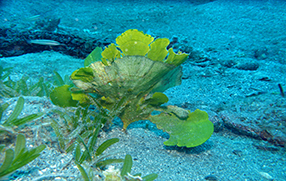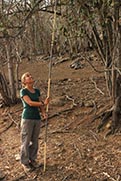Some examples of projects that have received grants are listed below.
2015 - Tim van den Boog - The interior forests of Suriname are still intensely used by the original indigenous inhabitants for their subsistence. To document their traditional knowledge on the forest products they use, a comparative ethnobotanical study was done amongst two Amerindian communities in West Suriname. The results help to clarify how forests are traditionally used and why they should be protected.
2015 - Luna van der Loos - During a biodiversity expedition in June 2015, a collaboration between Naturalis Biodiversity Center and the ANEMOON Foundation, macroalgae specimens were collected around Sint Eustatius and were subsampled for molecular analyses. 175 species of macroalgae were found, of which 95 represented new records for Sint Eustatius and one new to the Atlantic Ocean. As the marine macroalgae around Sint Eustatius was previously not well known, this survey has established a baseline for future research.
2015 - Elizabeth Haber - 'Ecosystem impacts of exotic plant species in the Caribbean. The fieldwork on Statia focused on two invasive plant species: Antigonon leptopus (coralita vine) and Leucaena leucocephala (mimosa tree). Ground-truthing data collected at 163 sampling points, are used to build a vegetation classification model using remotely sensed imagery. This vegetation map shows where these two species are dominant on the island and as such can be used for making management decisions.
2015 - Michaela Roberts. Invasive species threaten island ecosystems worldwide. Grazing species in particular decimate plant communities and destabilize soils. This project mapped the densities of three invasive grazing species on the island of Bonaire, Caribbean Netherlands, and assessed their impacts on the dry-forest. This data will enable us to conduct cost-benefit analysis into reducing overgrazing on this and similar islands, to direct future forest restoration efforts.
2015 - M. van der Velden. In Kwamalasamutu, Surinam, leaves of the Geonoma baculifera palm are used for roof thatching. Populations of this palm species decline due to overharvesting of leaves. By means of a defoliation experiment, the effects on growth and survival of the palm is assessed.
2012 - Chequita Bhikhi. Plant diversity and composition of the Grensgebergte and Kasikasima mountain region in Southern Suriname. Little is known of the forests and plant diversity of southern Suriname. The current research forms a first step towards documentation of floristic composition and diversity of this area, as part of a larger Rapid Assessment Program by Conservation International Suriname studying the flora & fauna of southern Suriname.
2011 - A. Mitsiou & A. Laporte-Bisquit - Spatial and temporal variation in above-ground biomass in tropical forests in French Guiana. The main aims of this research were to study the effects of selective logging activity on forest above-ground biomass and the spatial variation in above-ground biomass of primary forest. For this research project, field work was carried out in the Kaw Mountains, North-Eastern French Guiana.
2010 - B. Boom - Web publication on the Plants and Lichens of St. Eustatius, Netherlands Antilles. This virtual herbarium of plants and lichens publishes the collections made in 2008. The grant covers costs for online publishing of the data. The project is carried out by a team under the supervision of Brian Boom of the New York Botanical Garden.
2009 - B. Hoffman: Publication of the book Woody Climbers of Suriname Field Guide. This is a user-friendly, illustrated field guide that includes, among other things, a key based on vegetative characteristics. More than half of the book has already been written. The grant will help cover publication costs. The publication will be executed and supported in part by the National Herbarium of the Netherlands - Leiden University branch.
2009 - C. van ‘t Klooster: Medicinal Aromatic and Cosmetic (MAC) Plants for Local Health Care and Bio-cultural Diversity Conservation in the Saramaccan Village Pikin Slee, Suriname. In cooperation with the Herbarium of Suriname (BBS) and the local botanist F. van Troon, plant use by the local Maroon population is investigated. The research project is being conducted within the framework of the Master’s Program of Medical Anthropology and Sociology (University of Amsterdam, the Netherlands).
2008 - V. Merckx: Diversity and ecology of mycoheterotrophic plants on and in the vicinity of the Savane-Roche Virginie (French Guiana). Interaction between plant roots and fungi is common in plants that absorb nitrogen and phosphorus from the soil in exchange for carbon. Mycoheterotrophic plants are plants that “steal” the carbon that autotrophic plants have made available to the fungal network. Research was conducted in cooperation with J. Moonen (a local botanist) and the Catholic University Leuven, Belgium.
2008 - A. Temme: Genetic population structure of the common liverwort Cheilolejeunea rigidula (Nees. et Mont.) Schust. in the Amazon Basin. The relationship between the dispersal of mosses and liverworts (by means of spores or vegetative parts) and their final distribution pattern was determined using molecular genetic techniques. The relationships between geographically distinct populations were studied.
2008 - O. Bánki: A presentation titled “Tree diversity and nature conservation of bauxite mountains in Northeast Suriname” was given at the Association of Tropical Biology and Conservation (ATBC) Conference in Paramaribo, Suriname. In addition, contacts with other attending scientists were maintained, discussions conducted, and advice regarding fieldwork given.




